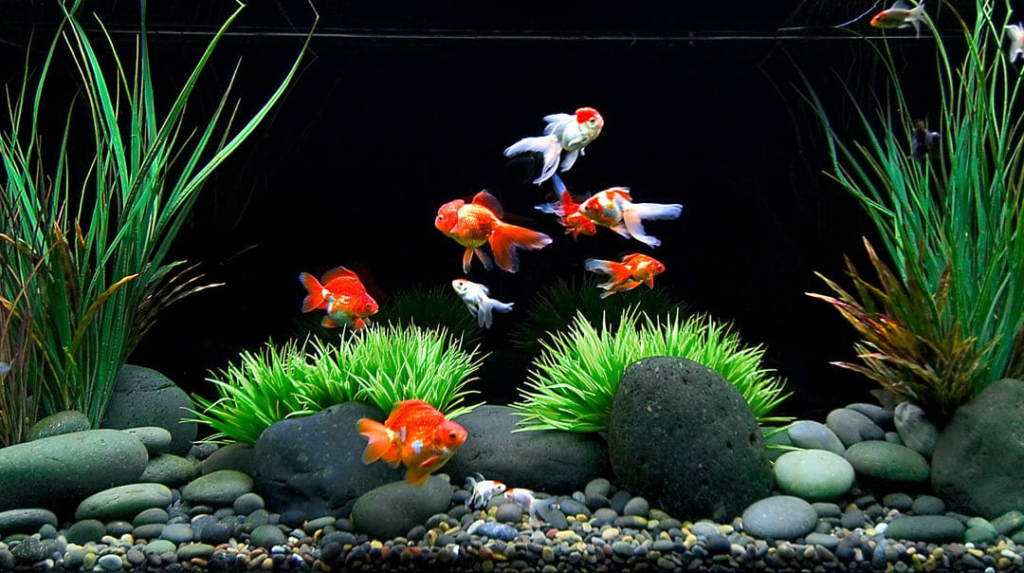
Enter the captivating world of goldfish – the tiny wonders that add life and color to aquariums worldwide. While their size might be small, their influence on our overall living space is unparalleled. From the flicker of their tails to the sparkle in their eyes, they form a mesmerizing spectacle that’s hard to ignore. And then, there’s the hypnotizing display of colors! But have you ever wondered what exactly makes your goldfish’s colors so vibrant? Let’s dive into the fascinating world of goldfish and explore their true colors.
Why Goldfish are Fascinating Creatures
Did you know the humble goldfish, besides being a staple in aquariums, carries a legacy dating back more than a thousand years? Originating from dull-colored carp in ancient China, selective breeding led to the creation of these shimmering beauties. But it’s not just their extensive history that makes them so fabulous. Brimming with personality, each goldfish has its own distinct character which evolves over time.
Goldfish also have commendable survival instincts. They can remember faces (so yes, they know their owners), navigate mazes, and learn tricks. Fancy, right? In fact, let’s put it on record that they should be treated as small, wet, orange pets with scales, not decoration! So, the next time you see your goldfish swimming gracefully in its tank, give it the credit it deserves. After all, there’s a lot more to this splendid creature than meets the eye!
The Truth About Their Captivating Colors
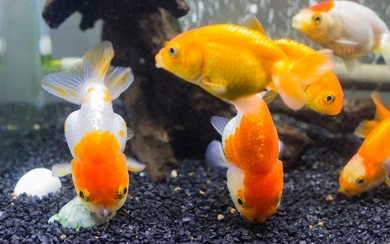
Now let’s talk about the absolute pièce de résistance – their alluring colors. One might hastily believe a goldfish is just – well, gold. Couldn’t be further from the truth. They come in an array of colors, from shiny gold to stark white, vibrant orange to deep black, and everything in between. You’d be hard-pressed to find a brighter, more diverse aquarium resident.
And those colors aren’t just for show. They play vital roles in things like camouflage, mate attraction, and health status signaling. But what influences these magnificent hues? Is it nature’s palette at play, or is there science behind it? More importantly, can you, as an owner, play a role in their coloration process? Cue cliffhanger music and keep reading, because that is exactly what we’re about to uncover in the next sections. Consider this your golden ticket to a spectrum of ‘Goldfishology’. Keep swimming!
The Science Behind Goldfish’s Colors
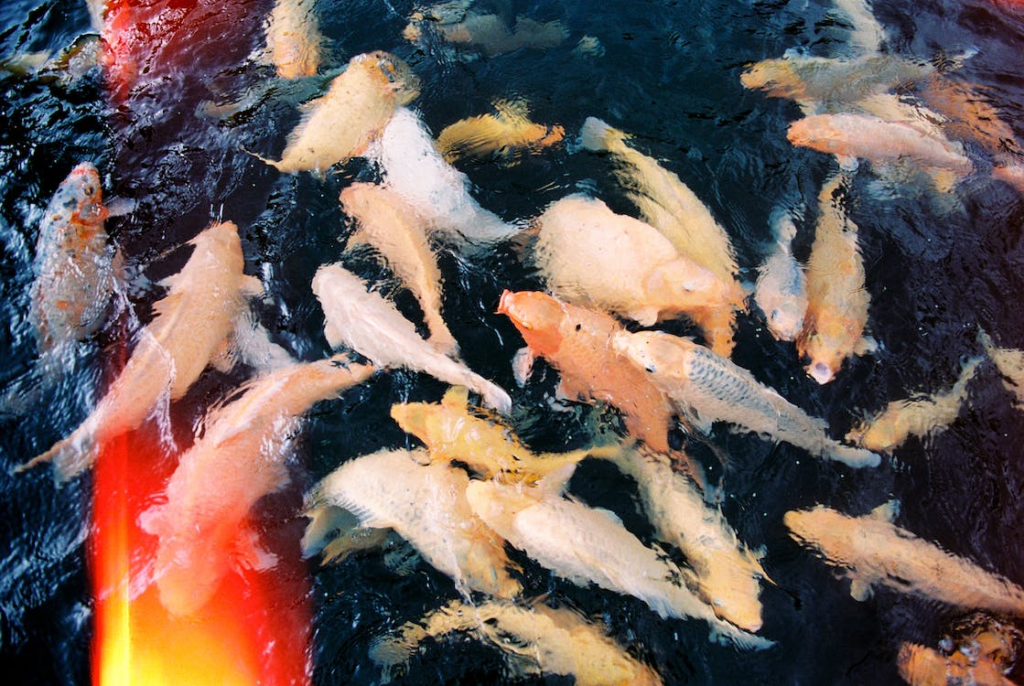
Grab your lab coats, folks! It’s time to dive deep into the fascinating world of goldfish colors. Don’t worry, we’ll keep it as simple as a leisure swim in a fishbowl.
Basics of Fish Pigmentation
Have you ever pondered whether your goldfish’s wardrobe requires regular updates? Like any self-respecting fashionista, a goldfish always keeps up with her color game. The secret is in her skin. Goldfish skin contains cells called chromatophores, packed with different pigments. Broadly, there are three types of pigments: melanophores (black/brown), erythrophores (red), and xanthophores (yellow). By controlling the size and distribution of these pigment cells, goldfish can modify their colors. It’s like having their very own, in-built spa experience!
But the color-changing trickery isn’t just for show. Colors also serve as an effective camouflage against predators and protective UV radiation. So, your little buddy isn’t just fashionable; it’s functionally genius too!
Now that we’ve scratched the surface of goldfish pigmentation, it’s time to explore some of the key influencers of a goldfish’s vibrant dress code.
Factors Affecting Goldfish Coloration
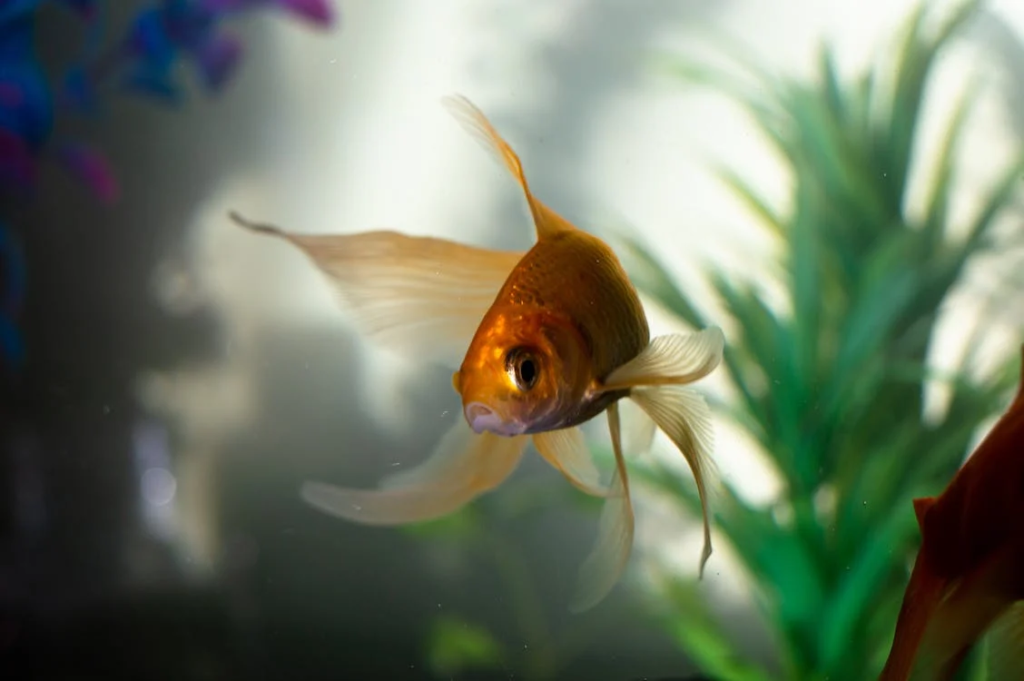
While genetics are the primary color dictators in goldfish town (sorry, you can’t breed a blue goldfish), several other factors govern the color palette.
Diet plays a significant role. Carotenes found in certain fish food can enhance your goldfish’s red and orange tones like a well-done makeup brush. On the other hand, sub-standard meals can leave your goldfish dull and lackluster, quite like you after a week of junk food binges.
The surrounding environment and lighting also tend to modulate goldfish coloration. Goldfish can adjust to their background color to hide from predators, giving them the Hollywood chameleon award in the tank. Also, prolonged exposure to sunlight can darken a goldfish’s color, much like a suntan works for humans.
Armed with the essential theory of goldfish coloration, it’s time to get practical. Hold tight as we dive deeper into the ways you can positively influence your goldfish’s color in the next section. Cue the drum roll, please!
How to Nurture Your Goldfish’s Vibrant Colors
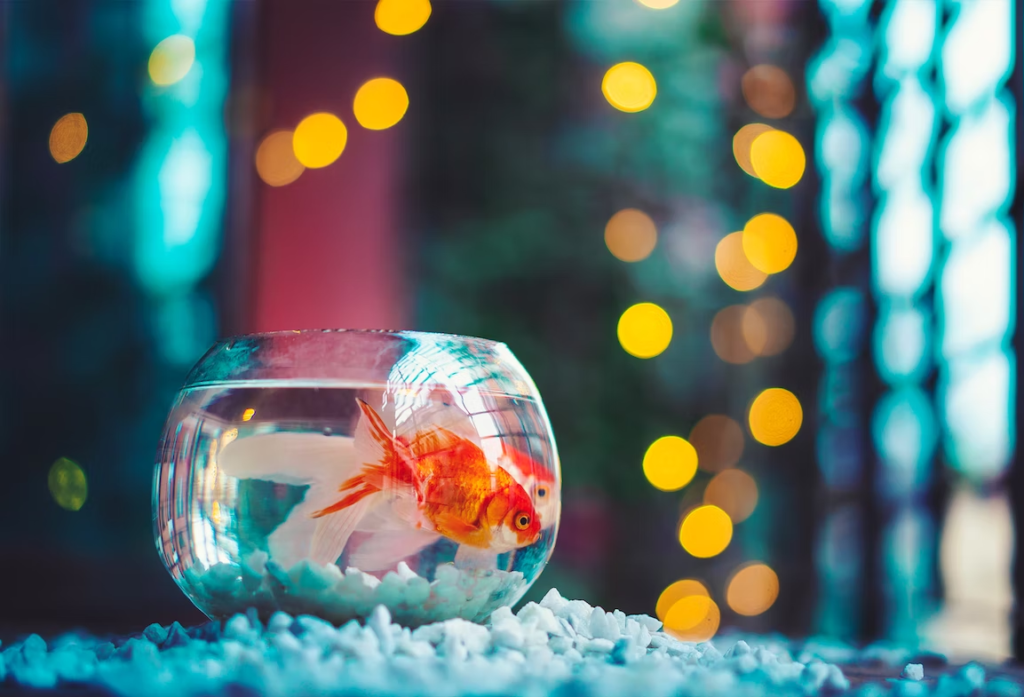
So, we’ve talked about the science behind those alluring goldfish colors and why they’re more than just small swimming rainbows. Now, let’s move to the exciting part – how you, as a goldfish parent, can help make those shades pop! After all, who doesn’t want the enviable honor of having the flashiest goldfish in the neighborhood? Alright, fasten your seat belts, and let the magical nurturing journey begin.
Proper Diet for Color Enhancement

It’s often said, “You are what you eat.” but the same applies to our golden little friends too! Goldfish hues are significantly influenced by their diet. First off, you need to know that color-enhancing foods aren’t the fishy equivalent of your grandma’s secret pasta sauce recipe. These feeds typically contain ingredients like spirulina, shrimp meal, marigold petal extract, and various types of pigmented algae.
When thinking of goldfish food, it’s essential to think beyond flakes. Fresh, frozen, and live food can make a world of difference. You can feed them brine shrimp, daphnia, and spirulina. Occasionally, you can indulge your goldfish with vegetable treats like peas and lettuce to keep it balanced.
Now that we’ve got diet checked off of our list, remember that overfeeding can lead to health issues, which might dull your fish’s fabulous color. So, moderation is key! Foster a foodie in your goldfish, but don’t let it become a glutton!
Alright, so you’re now equipped with tips and tricks to enhance your goldfish’s diet (you might even find them doing a little happy swim after meal times!). But is that all? Not quite! While you might be wanting to run and revamp your goldfish’s pantry (or should we say tank-try?), let’s take a pause and understand the role of environment and lighting because, trust me, they play a massive part in this color game.
Role of Environment and Lighting
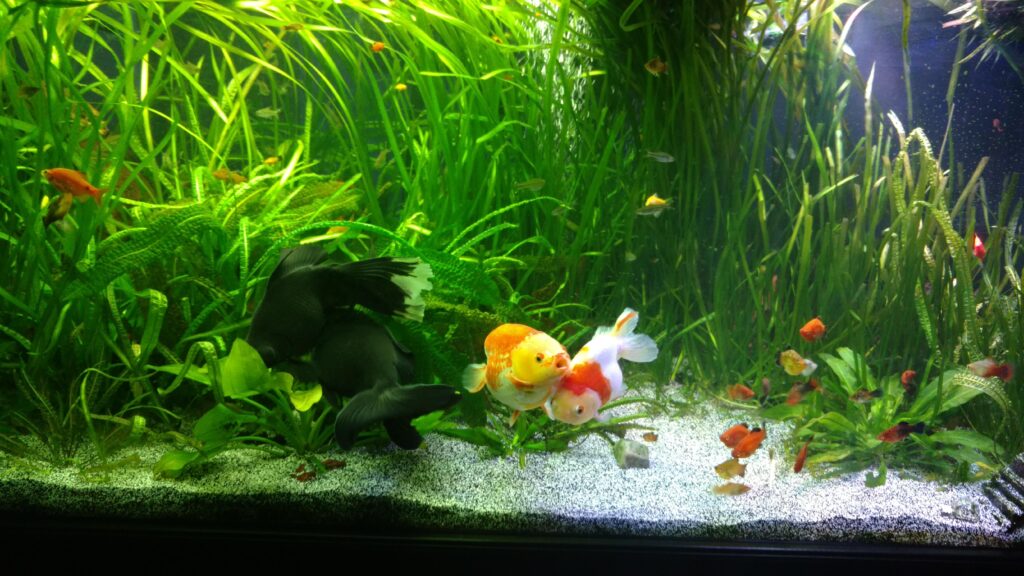
Let’s talk about your goldfish’s crib – the environment. The setup of your goldfish tank plays a significant role in maintaining its vibrant colors (and no, it’s not just about choosing a fancy, modern tank – though it couldn’t hurt to stay on trend!)
Firstly, goldfish are social creatures. Don’t let your goldfish pull off a solo act. Add a few companions in there, preferably others of the same species. This helps alleviate stress and keeps your goldfish happily entertained.
Then we have the lighting aspect. Imagine being in dim lighting all day; you’d likely get all moody and lackluster. It’s the same for our aquatic friends. 8-12 hours of indirect or artificial light per day can help keep their colors vibrant. Consider adding a suitable aquarium light if your tank isn’t getting enough natural light.
A less appreciated factor is the color of the tank’s background and base. Darker settings tend to cause your goldfish to darken, while lighter settings can cause it to pale. So, choose wisely based on the type of aesthetic you want.
Now that we’ve checked off the environment and lighting, it’s clear that nurturing your goldfish’s true colors is an intimate blend of diet, the right environment, and adequate lighting. Still, your decisions do matter (maybe you’ll finally understand why your goldfish gave you that reflective glare when you bought that neon tank decor!). Up next, we’ll talk about how your choices influence your goldfish color – don’t miss out, especially if your sense of style often gets questioned!
Choices You Make Can Influence Your Goldfish’s Color
And now, we turn to the meat of our discussion: how your decisions could potentially turn your goldfish into a living, swimming rainbow—or a faded shadow of its former self. Don’t worry, it’s not about the butterfly effect and you won’t need a PhD in Fishology. However, your hands are on the reins, and how you guide them can lead your goldfish to express its most vivid colors.
The Right Tank Setup
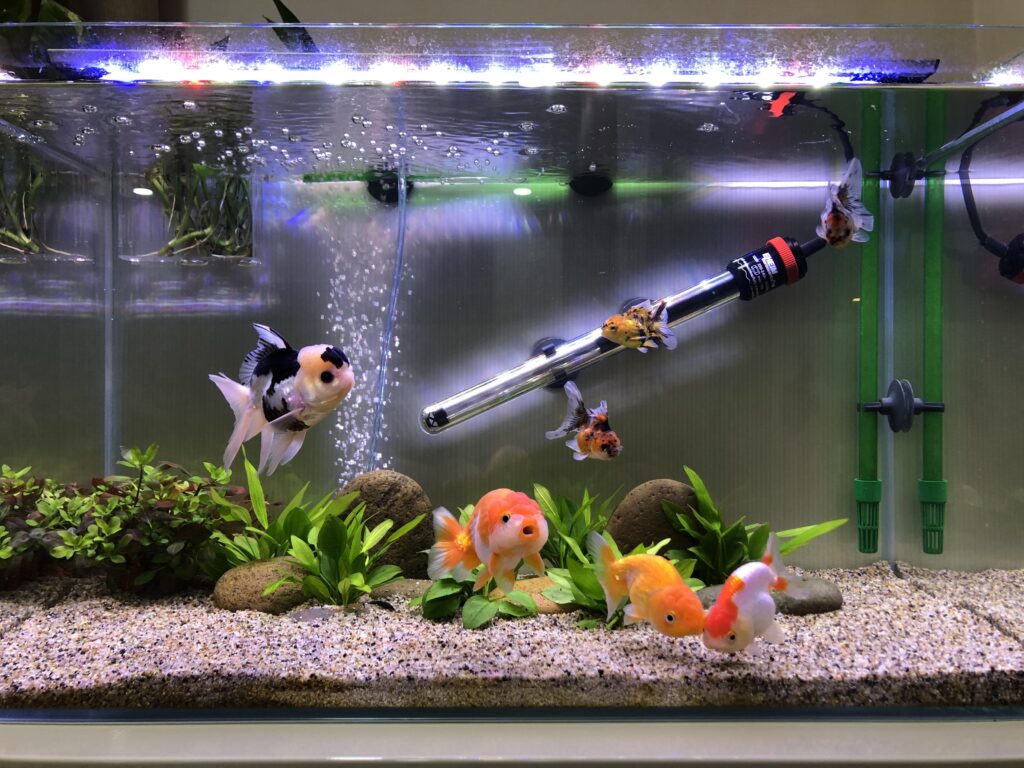
Let’s start with your fish tank. Think of it as your goldfish’s luxury condo. Strike that—a luxury condo with all utilities included: light, heat, space, decor, and room service.
Goldfish love space, so don’t coop them up in a small bowl. The larger the tank, the happier and healthier your goldfish will be. This happiness, believe it or not, can influence the vibrancy of their colors.
Next, consider the decor. While a tank full of hot pink plastic plants might appeal to your inner interior decorator, it’s not exactly natural for your fishy tenant. Opt for a setup that replicates their natural environment. Go for real plants, subdued lighting, and a gravel substrate that’s similar to their natural habitat. It will make them feel more at home and help them flaunt their original, vibrant colors.
Now that we’ve decked out your goldfish’s crib, let’s dive into the deeper (and somewhat murkier) side of goldfish colors. Hold on tight, because we’re about to uncover some fishy color mysteries.
Understanding Color Changes and What They Mean
Color alterations in your goldfish can be like trying to decipher Morse code while juggling flaming chainsaws. Simply put, it’s challenging.
Sometimes, your goldfish may darken overnight, only to lighten again a few days later. Other times, orange turns to white, or black spots just suddenly appear. So, what’s going on?
Changes in color can indicate different things, many of them health-related. So, pay attention and keep a watchful eye out for extreme changes. Stress, poor health, or a lack of nutrients can cause your goldfish to lose their vibrancy and turn paler. On the flip side, ensuring a good diet and health regime can help your goldfish show their true colors—and yes, they’re spectacular.
Now, brace yourselves. We’re about to plunge into the world of myths, legend, and old wives’ tales. Join us as we shine a light on these shades of truth and debunk some common misconceptions about your goldfish’s color.
Most Common Myths About Goldfish Colors
Have you ever come across a fishy story about goldfish colors that made you go, “Oh really now?” Well, hold onto your nets because we’re about to go myth busting. Let’s dive into the murky waters of goldfish color misconceptions and cast a net of truth to surface with the facts.
Debunking color-related misconceptions

Firstly, there’s the widely spread myth that all goldfish are, well, golden. In reality, these little aquatic Picassos can come in a vibrancy of colors ranging from red, orange, yellow to black and even blue. Fun fact: Some goldfish are calico, sporting a multicolored pattern that might make you think they’ve rolled around in a toddler’s art set.
Another common misconception is that goldfish lose their color because they’re old and rusty. Well, unlike your technicolor dream carp, your goldfish’s color has nothing to do with aging. Color changes can be due to various factors like diet, exposure to light, or overall health.
Lastly, many believe that goldfish turning white is a tell-tale sign of goldfish ghosts (spooky). Quite the contrary, a goldfish changing color, even to stark white, can be a completely normal part of their life and not necessarily a Halloween horror story revolving around your fish tank.
Now that we’ve dusted off these myths, let’s switch gears and find out exactly how you can help maintain your goldfish’s vibrant vivacity. After all, who wouldn’t want a personal, pocket-sized, swimming rainbow?
Efficient ways to maintain color vibrancy
Want your goldfish to keep strutting their bold hue with sass? Here are some efficient ways to ensure your fish stays fabulously flamboyant.
Diet, my dear friends, is a biggie. A balanced diet rich in nutritious foods can really crank up the color volume. Brine shrimp and Spirulina algae are the superfoods of the fish world, fantastic for enhancing colors.
Secondly, just as your tan intensifies with sunlight, so does your goldfish’s color with proper lighting. Always ensure your goldfish have a healthy dosage of light.
Last but definitely not least, a clean and spacious environment is vital. Their comfort zone directly impacts their color. So get that aquarium cleaner pronto and always keep an eye out for necessary updates to your tank setup.
And voilà! You’re now a walking, talking goldfish color expert. Now, before we wrap up this dazzling escapade into the world of goldfish tones, let’s bring it back and remember why flaunting their true colors is so vital. Prepare for one grand finale as we dive into our conclusion.
Conclusion
Calling all ye Goldfish Grannies and Guppy Grandpas, we’ve swum the length and breadth of our nifty guide, dived beneath the surface, and sifted through the shifting sands of goldfish color knowledge. Are you feeling a little more fish-savvy now? Good, because it’s time to wrap things up.
Revisiting the importance of fostering your goldfish’s colors
Now, if there’s just one thing you should take away from our deep dive – and no, it’s not that goldfish make great underwater disco balls – it’s that your goldfish’s radiant glimmer and fiery hues are far more than just an aesthetic perk.
No siree, Bob! Their vibrant tones are a reflection of their general health, diet, and environment, their very personal ‘scale tale’ if you will. From the nutrition-rich pellets you sprinkle into their tank, the well-thought-out lighting, to the zen-like ambiance you create – everything plays a critical role in shaping your goldfish’s color narrative.
In a fish-eat-fish world, becoming an honorary godparent to your goldfish’s true colors means knowing that a dynamic color change isn’t always cause for alarm. Sometimes, it’s a simple sign of your goldfish hitting ‘scale puberty’ or waving the ‘I’m ready to mate’ flag. Remember, they’re creatures of adaptation, gradually evolving to mold their environment.
Debunking the myths about ‘goldfish grey-out’ and understanding the factors behind their color transition is essential. It’s about disentangling truth from ‘turtle tale’ and ensuring your finned friends continue to brighten your days, their kaleidoscopic colors spinning a captivating saga in the heart of your living room.
So next time you’re gazing into your tank, witnessing the kaleidoscope of colors that your goldfish present, remember: You’re not just observing shades of orange, red, yellow, or gold. You’re celebrating a vibrant, living testament of your love and care, a multi-hued splash of life that is uniquely yours to nurture.
Alright, fellow fish-whisperers, this is where we anchor and conclude our fishy expedition. Armed with newfound color insights, you’re all set to enhance your goldfish’s life and lively hues.
Frequently Asked Questions (FAQ)
Question 1: Why are goldfish colors so captivating?
A: Goldfish colors are captivating due to their natural pigmentation that’s enhanced by factors like diet and lighting. They appear more vibrant than many other types of fish, making them an excellent choice for pet fish.
Question 2: What influences a goldfish’s color?
A: The color of a goldfish is primarily influenced by its genetics. However, factors such as diet, lighting, and the environment in which it is kept can also significantly affect their coloration.
Question 3: Which foods can enhance my goldfish’s color?
A: Fish foods fortified with carotenoids, a type of pigment found in many plants and animals, can help enhance your goldfish’s color. Feeding your goldfish a balanced diet including brine shrimp, spinach, and peas may also enhance their color.
Question 4: How does the environment affect a goldfish’s color?
A: A clean environment with proper lighting helps to maintain and enhance a goldfish’s color. Stress factors like changes in temperature or water quality can lead to color changes. A dark-colored tank background can also help their colors pop.
Question 5: Can changing a goldfish’s tank setup affect its color?
A: Absolutely. Along with providing a clean, stress-free environment, using a darker substrate or background can help your goldfish’s vibrant hues really stand out.
Question 6: What do color changes in a goldfish mean?
A: Color changes may be signs of stress, disease or natural aging. If your goldfish is turning white or losing its color very quickly, it’s best to consult a vet or fish expert.
Question 7: What is the most common myth about goldfish colors?
A: One common myth is that goldfish will adapt their color to match their environment. In reality, while extreme stress or poor health can lead to color changes, your goldfish won’t turn blue just because you paint its tank blue.
Question 8: How can I maintain my goldfish’s vibrant colors?
A: The keys to retaining your goldfish’s vibrant colors are: providing them a balanced diet, ensuring they have an optimal environment with appropriate lighting, keeping their tank clean, and monitoring their color for any sudden changes.
Question 9: Do goldfish colors fade with age?
A: Yes, similar to humans going grey, with age, a goldfish may lose pigmentation and its colors might fade. However, with proper care and nutrition, your old goldfish can maintain its vibrancy much longer than you might expect.
